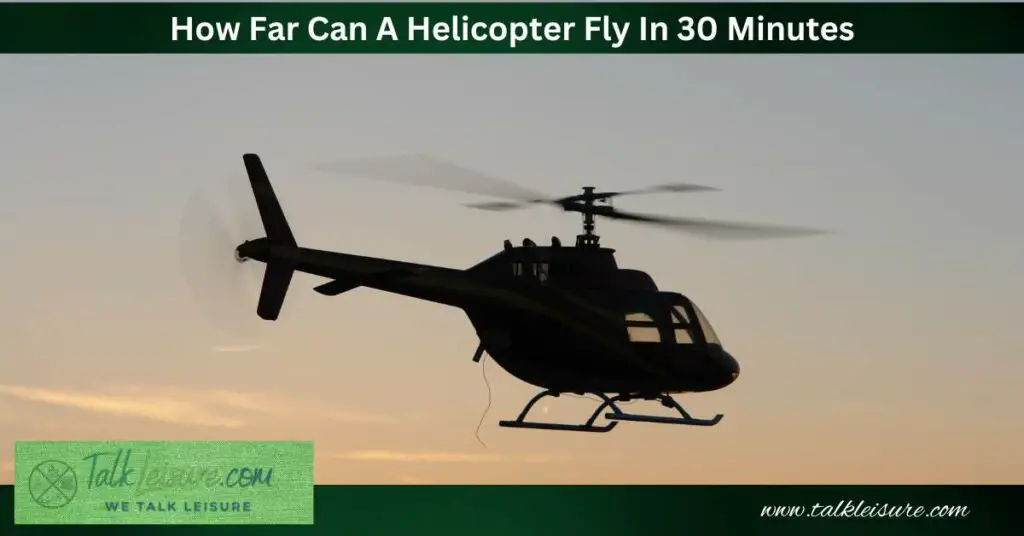I see it in movies all the time: a helicopter swoops in, picks up a stranded survivor, and quickly whisks them away to safety just as the clock runs out.
But how long exactly can a helicopter fly in 30 minutes?
Could it be just in time to save our hero from certain doom?
Or will it fall short, leaving them behind to face their fate?
You can visit many amazing destinations within 30 minutes around the USA.
Let’s strap ourselves in and explore the captivating world of helicopter flight times, distance capabilities, and the many factors determining how far a helicopter can fly in that crucial 30-minute window.
The blades are whirring, and our adventure awaits!
When it comes to the fascinating world of helicopters, one question that often arises is how far a helicopter can fly in 30 minutes.
This query stems from people’s excitement and curiosity about helicopters, as they offer a unique perspective of the landscape and terrain below.
Several factors must be considered to answer this question, such as the type of helicopter, fuel capacity, average speed, and other aspects of the aircraft.
Generally, helicopters can fly from 150 to 200 miles per hour. Given this information, it can be estimated that a helicopter can cover a distance of about 75 to 100 miles in 30 minutes.
How Far Can A Helicopter Fly In Thirty Minutes
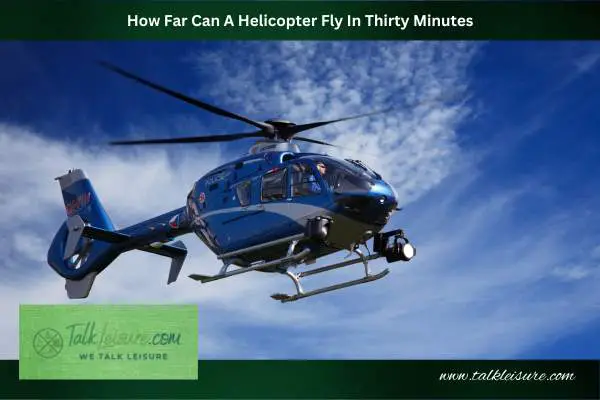
For those curious about the distance a helicopter can cover quickly, let’s look at how far one can fly in just 30 minutes.
On average, helicopters travel at a speed of 150 to 200 miles per hour, depending on the type, weight, and size of the helicopter, as well as weather conditions.
With this in mind, in a period of 30 minutes, a helicopter could cover a distance ranging from 75 to 100 miles.
It is essential to note that these figures are approximate, and the distance may vary depending on specific circumstances.
High-performance helicopters with enhanced capabilities and features may be able to cover greater distances.
In contrast, others may not travel quite as far due to speed and fuel capacity limitations.
Various factors can influence a helicopter’s flight range, including the type of helicopter, its weight, the size of the fuel tank, and prevalent weather conditions.
Military, commercial, and private helicopters serve different purposes and may have different capacities to cover distances.
A smooth flight without frequent slowdowns or hovering increases the effective flight range.
Overall, a helicopter’s ability to cover the distance in 30 minutes is dependent upon numerous elements, making the exact distance achievable variable from one flight to another.
If you are planning to take a helicopter, it is better to carry an inhaler with you, as it will be helpful if you feel hard to breathe at dizzying heights.
Chewing citrusy snacks will help fight nausea during long flights.
What Are The Legal Requirements That Influence A Helicopter’s Flight Range?
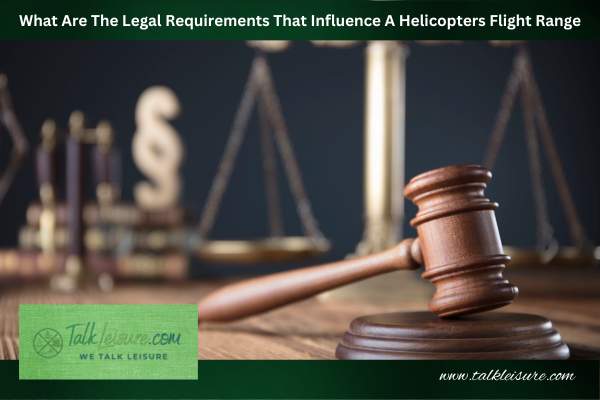
Legal requirements greatly influence a helicopter’s flight range, regardless of its abilities.
First and foremost, helicopters must adhere to governmental and aviation authorities’ guidelines, which can vary depending on the situation.
These regulations often dictate where the helicopter is permitted to fly and any restrictions on its flight path.
Flying in busy areas, such as commercial airports, is typically not allowed for helicopters due to heavy air traffic.
Likewise, helicopters must respect private property boundaries and avoid flying over business premises without proper approval.
Additionally, unless special permission is granted, helicopters cannot cross borders or fly from one country to another.
Moreover, customs regulations can also play a role in determining a helicopter’s flight range, as they might necessitate unforeseen stops or rerouting.
As a result, pilots must be aware of and comply with all legal requirements to ensure a safe and enjoyable flight experience.
Whether you are traveling in a flight or helicopter, when flying with trigeminal neuralgia or other sickness it is better to get legal confirmation from your doctor.
What Are The Other Factors That Affect The Range Of A Helicopter?
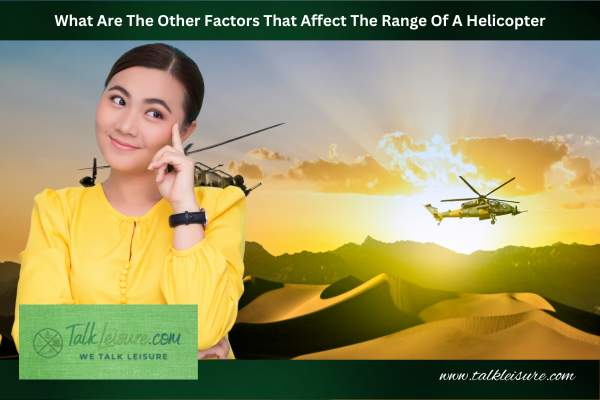
Several factors outside of legal requirements can also influence the range of a helicopter.
Following are a few other factors that may impact the helicopter’s flight range:
Type Of The Helicopter
Helicopters come in various types and sizes, greatly impacting their flight range.
For instance, commercial and private helicopters typically have an average speed of 150 to 175 miles per hour, allowing them to cover around 75 to 87.5 miles within 30 minutes.
Military helicopters, however, can fly even faster, some reaching speeds of 195 miles per hour.
One of the fastest civilian helicopters available today is the Airbus Helicopters’ H155, capable of up to 200 miles per hour.
At the same time, the Lockheed AH-56A Cheyenne boasts the longest range of any helicopter, at 1,225 miles.
Weight Of The Helicopter
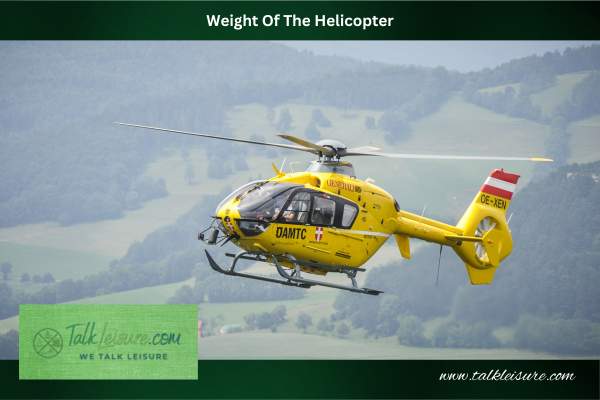
The weight of a helicopter plays a crucial role in determining its flight range, especially when considering its capacity to travel within a specific time frame, such as 30 minutes.
Generally, heavier helicopters require more power to maintain altitude and will consume fuel faster, ultimately reducing their flight range.
In contrast, lighter helicopters are more fuel-efficient and boast a longer flight range, making it possible to cover greater distances within the same 30-minute time frame.
Helicopter weight can be affected by various factors, including the type of helicopter, its size, and any additional equipment or cargo on board.
For instance, private helicopters are typically smaller and lighter, allowing them to travel greater distances than their larger commercial counterparts.
Engine
A helicopter’s range is significantly influenced by various factors, including its engine type, weight, fuel efficiency, and weather conditions.
In general, most helicopters can cover a distance of about 200–450 miles, with piston-engine helicopters having a range of approximately 200–350 miles and gas-turbine-powered helicopters flying around 300–450 miles.
One crucial factor to consider is the helicopter’s engine type.
Piston engines are heavier but more fuel-efficient, making them ideal for flight schools and first-time owners who may not require long-distance travel.
On the other hand, gas turbine engines are lighter and enable helicopters to fly at higher speeds, increasing their range.
Pilot Techniques And Experience
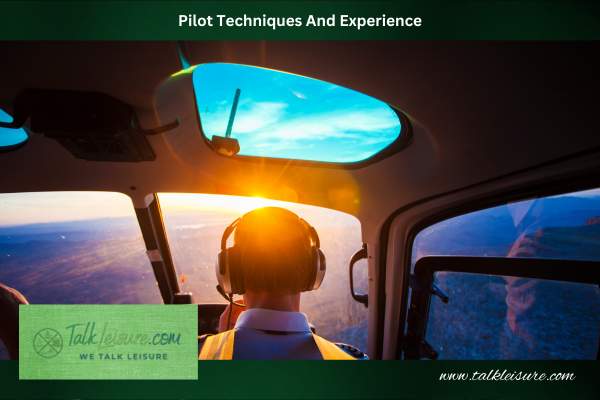
Helicopter flight range is not only determined by the type, weight, and fuel capacity, but also by the pilot’s skill and experience.
A proficient pilot can significantly extend the flight range by employing various techniques to conserve fuel and maintain optimal speeds.
Even a felon can become a pilot if he has a felony conviction and is legally approved by the FAA.
One key strategy is utilizing the best cruise speed, which is the rate at which the helicopter consumes the least amount of fuel per nautical mile.
This speed varies with the aircraft type and environmental conditions, but a skilled pilot consistently maintains it.
Another crucial factor is efficient hovering techniques.
Hovering consumes more fuel than flying, so a competent pilot will minimize hovering time by swiftly transitioning to forward flight and maintaining precise control during landings and takeoffs.
Weather Conditions
One of the factors that greatly impact a helicopter’s range is weather conditions.
When flying in clear skies with little to no wind, helicopters can cover more distance in a short time.
Wind speed and direction can impact the progress of a hot air balloon, helicopter, or flight.
However, various weather elements can greatly affect the helicopter’s performance and its ability to maintain optimum speed and flight efficiency.
For instance, strong crosswinds or headwinds can slow down the helicopter, making it challenging to maintain a steady flight path and cover as much distance as possible under favorable conditions.
On the other hand, tailwinds can help increase the flight range as they speed up the aircraft.
Flying in adverse weather conditions such as snow, fog, or rain can significantly impact visibility.
Therefore, during heavy rains, it is highly recommended to avoid hot air balloon rides or helicopter flights.
This requires the pilot to exercise extra caution and, in most cases, increases the necessity of flying slower.
Consequently, the effective flight range of the helicopter is reduced.
In worst-case scenarios, severe weather conditions may even force the helicopter to land and wait for better flying conditions, further impacting the range covered within a specific time frame, like 30 minutes.
Additional Fuel Tanks
One major factor that can drastically increase a helicopter’s flight range is the use of additional fuel tanks.
These extra tanks allow the helicopter to carry more fuel, providing an extended flight duration and coverage.
They can be particularly beneficial for helicopters frequently undertaking long-distance trips, such as those used in search and rescue missions, military operations, or expeditions to remote areas.
Helicopters with additional fuel tanks are typically designed to manage their weight, even when fully loaded with fuel.
The extra weight of these tanks can be offset by a powerful and efficient engine, which ensures that the helicopter can maintain optimal performance despite carrying more fuel.
Sometimes, helicopters may even be fitted with multiple additional tanks to extend their range further.
More fuel can be especially advantageous in emergencies, where reaching a destination or returning to base as quickly as possible is of the utmost importance.
Additional fuel tanks are a significant factor that can enhance a helicopter’s flight range.
Fuel capacity And Efficiency
One of the primary factors that determine the range of a helicopter is its fuel capacity and efficiency.
A helicopter’s fuel tank size directly affects how far and long it can travel without refueling.
The larger the fuel tank, the longer the flight range. However, this is also dependent on the helicopter’s engine efficiency.
Modern helicopters are designed with various fuel capacities and engine systems to meet specific operational requirements.
Helicopter manufacturers continue to innovate and develop advanced engine systems to increase fuel efficiency and flight range to cater to the diverse needs of pilots and passengers worldwide.
What Are The Best Long Range Helicopters? (Top 3 Choices)
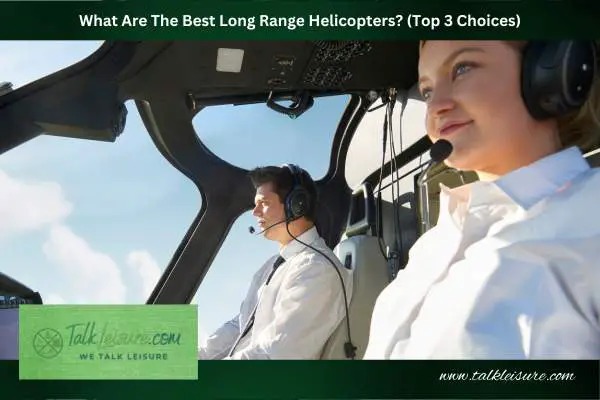
The best long-range helicopters provide exceptional performance, comfort, and versatility.
The following are the top choices of long-range helicopters that are ideal for flying long distances with increased speed and efficiency.
1. Leonardo AW101
The Leonardo AW101 ranks at the top of long-range helicopters.
This sleek aircraft can effortlessly cover vast distances with a maximum range of 810 nautical miles (1500 km).
Designed to accommodate a variety of missions, from offshore operations to search and rescue, the AW101 is the ideal choice for those seeking a reliable, high-performance helicopter with an impressive flight range.
2. Leonardo AW189
The Leonardo AW189 is a highly capable long-range helicopter known for its impressive performance and advanced safety features.
This twin-engine aircraft can cover a distance of up to 1000 km (621 miles), cruising at speeds of around 311 km/h (193 mph).
With a maximum altitude of 6000 meters (19685 feet), the AW189 can carry up to 16 passengers and two pilots.
This helicopter offers a spacious cabin and a four-axis digital autopilot system that is ideal for missions such as offshore oil and gas operations, search and rescue, and VIP transport.
This system grants pilots greater control over the aircraft, making the Leonardo AW189 a top choice for those seeking a dependable long-range helicopter.
3. Airbus Helicopter ACH175
The Airbus Helicopter ACH175 is a remarkable long-range helicopter known for its efficiency and versatility.
With a maximum range of 1,214 km (651 nautical miles), this powerful aircraft is designed to cover impressive distances in short timeframes.
In just 30 minutes, the ACH175 can travel approximately 100 miles, allowing riders to reach their intended destination rapidly.
Furthermore, this sleek helicopter offers exceptional comfort and performance, providing users with a dependable and enjoyable flying experience.
Final Thoughts
In conclusion, a helicopter can cover a substantial distance in 30 minutes, offering passengers a unique and breathtaking experience.
With skilled pilots, helicopters provide an unforgettable way to explore picturesque landscapes and iconic landmarks.
So, the next time you plan a memorable adventure, consider a 30-minute helicopter tour for a truly unforgettable experience.
Related Posts: Can You Fly Anywhere With Private Pilot License?
FAQs
How High Can A Helicopter Fly?
Helicopters generally have a maximum altitude of around 5,000 feet, as this range offers safety and maneuverability.
However, high-performance helicopters can reach heights of up to 10,000 feet.
Some have even pushed their limits to around 14,000 feet, although oxygen supplies may be necessary for passengers at these heights.
What Fuel Does A Helicopter Use?
Helicopters use two types of fuel, depending on their engine type.
Piston-powered helicopters operate on aviation gasoline (avgas), similar to car gasoline but without ethanol.
On the other hand, turbine-powered helicopters use jet fuel, the same type utilized by large airliners.
Fuel consumption and efficiency depend on the helicopter’s size and engine capacity.
Can A Helicopter Fly In The Rain?
Yes, helicopters can fly in the rain, but it depends on the intensity of the rainfall and visibility conditions.
Light rain with good visibility may not hinder a helicopter’s flight.
During heavy rain, it is safe to avoid flying on hot air balloons, helicopters, and airplanes to reduce the risks caused by invisibility.
However, due to safety concerns, heavy rain, fog, or low clouds can lead to flight cancellations.
Helicopter pilots always prioritize the safety of passengers and adhere to strict aviation regulations when flying in adverse weather conditions.
If a helicopter tour is booked and the weather becomes unsuitable for flying, the tour operator will typically offer rescheduling or a refund.

